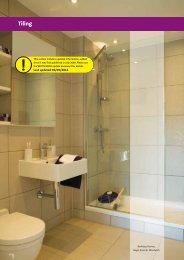SITE BOOK - Plaster systems - British Gypsum
SITE BOOK - Plaster systems - British Gypsum
SITE BOOK - Plaster systems - British Gypsum
Create successful ePaper yourself
Turn your PDF publications into a flip-book with our unique Google optimized e-Paper software.
Technical support: T 0844 800 1991 F 0844 561 8816 E bgtechnical.enquiries@bpb.comwhich is made from limestone, brick, granite and certainlightweight aggregates will require pre-treatment withThistleBond-it.In order to reduce the risk of cracking to a minimum, thefloating coat should be applied with sufficient pressure to fillall gaps between the units.With composite ceilings, the concrete beams should be pretreatedwith ThistleBond-it. If required, the suction of theinfill panels can also be controlled.Composite wall structures, consisting of concrete columnswith brick or block infills, can cause plaster cracking due todifferential movement. To overcome this, a heavy dutybuilding paper should be applied over the concrete columns,lapping over the brick or blockwork by a minimum of25mm. Expanded metal lath is then fixed over the buildingpaper and the edges secured to the brick or blockwork. Bythis means the reinforced plaster is isolated from theconcrete allowing it to move independently.Where the width of a column exceeds 300mm an additionalrow of fixings should be provided to secure the metal lathcentrally down the column. Where there are concrete beamsabove the infill bricks or blocks, the metal lath should also befixed to the concrete using suitable fixings.Pre-treatment of very high or low suction backgroundsWith the exception of skimming with Thistle Uni-Finish,backgrounds such as glazed bricks, exceptionally smoothconcrete or concrete made from limestone, brick, graniteand certain lightweight aggregates, will require preparationand pre-treatment with ThistleBond-it bonding agent priorto plastering. The surface should be thoroughly cleaned andallowed to dry before pre-treatment.Thistle GypPrime bonding agent should be used topre-treat surfaces where suction is extremely high. Withsome very porous surfaces, wetting alone may beinsufficient as the water is almost immediately absorbed.If there is any doubt about the suitability of a background fordirect plastering, a trial panel should be plastered and testedfor adhesion once dry. If adhesion is inadequate, theappropriate bonding agent must be applied to thebackground prior to plastering.ThistleBond-it bonding agent is specially formulated for useon smooth backgrounds. It has many advantages over PVAand is the only product recommended by <strong>British</strong> <strong>Gypsum</strong> foruse with Thistle plasters. Benefits include :– Contains fine aggregates for better mechanical adhesion.<strong>Plaster</strong> <strong>systems</strong>9417





